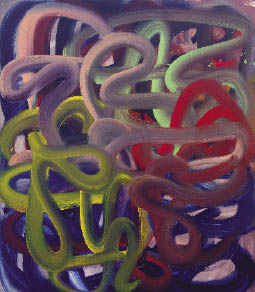Next story: Stagefright
Invitation To Dance: Karin Davie's Paintings at the Albright Knox Sweep You Off Your Feet
by Cynnie Gaasch
Karin Davie’s lively paintings swell and curve, enticing you into their vivid, expansive surfaces. The Albright-Knox Art Gallery is the first to showcase such a broad range of the artist’s paintings and drawings, all works she has made over the past 15 years. Davie has received particular attention for her “Pushed, Pulled, Depleted and Duplicated” series, with publications in ArtForum and Art in America; these are perhaps the most dynamic of the works on display at the Albright-Knox. The canvases are colorful and larger than body size. The artist uses large paintbrushes and rainbows of color to make acrobatic paintings in which she manipulates the tools of abstract painting. She creates curves and loops out of gestural stripes of color that fold in and out of themselves.

Dance is another major influence on Davie’s work. The physical sensibility—where you can visualize the artist stretching and bending in order to execute the paintings—clearly illustrates an alliance with dance. The definition of each painting, its limitations and goals are specifically tied to the minimalist approach of Trisha Brown, where the choreography could be as simple as 10 people standing in a line, just barely touching each other, slowly shuffling across a stage. The marathon aspect of John Cage’s 52-Hour Piece is evident in her work as well.
Davie knows her goals and limitations when she starts a painting. Working recently with only wet-on-wet paint, she needs to begin and complete a painting in the space of one day, or else wipe it all down to begin again. With the “Pushed, Pulled, Depleted and Duplicated” series, Davie started with projected sketches so that she knew the basic forms within which to work. These paintings were in a sense choreographed before they were begun, though they look spontaneous. There is accident and discovery all over the place in her work, which keeps it vital.
The energy created by Davie as she makes her paintings rolls out of the canvases. More than the work of any of the abstract expressionists before her, these paintings, because each one is so specific in its intention, are like lessons in the appreciation of a painting. This is especially the case in her most recent works, the “Between My Eye and Heart” series. With these paintings, she begins at the top of the rectangle and gracefully fills the space of the painting in an entirely improvisational dance. Some of the stripes and loops layer to the point where they seem to bulge or fall out of the canvas. The lines push against the edges of the canvas, only occasionally skipping off the edge to enter back into the rectangle at another point.
While the creation of the work—the execution of it—is practically unfathomable, the process she reveals is almost like a description of how to make a painting, even though most of the earliest marks are covered up by the time she has completed a piece.
Davie does not mix paint in advance of the painting process, but continuously refills her brush, mixing paint on the canvas, as she moves the brush along. The stripes in these works are each about four to six inches across, and she somehow moves the brush as she goes along so that many of the lines look three-dimensional or tubular. The paintings move in and out, and your eye follows the beautifully flowing line around the canvas. Bright yellow paint often shines from the top and behind the latter marks.

Davie continues her fascination with the warping of images in the series titled “Interior Ghosts.” When speaking of this series, she refers to the funhouse mirrors that twist and manipulate reflections. The colors are like a clown’s face paint. Bright reds and turquoise, paired with yellow and white, describe the high arch of an eyebrow. Her title for this series makes clear that she isn’t just talking about the fun of a circus, she is talking about the fears that are masked and played with in the “fun” house.
Other paintings made in the early 1990s in this exhibit show Davie’s evolution from a fairly direct stripe painter, experimenting with the three-dimensional illusions of curving lines across a painting’s surface. Early paintings show the stripes simply swelling at the bottom of two panels. Next, the stripes bulge in the lower half of the painting, looking like a piece of striped clothing stretching over a woman’s bosom. Later, the paintings create an optical illusion, where the effect is so substantial; it looks like the canvas is shaped and careening off of the wall.
All of this experience feeds into the control she displays in the “Pushed, Pulled, Depleted and Duplicated” and “Between My Eye and Heart“ series. Davie’s understanding of the movement of line is exceptionally powerful.
Karin Davie’s show continues through May 14. Rizzoli has published a catalog with essays by Barry Schwabsky and Lynne Tillman, a foreword by Albright-Knox Director Louis Grachos and large, beautiful illustrations of the artist’s work, which may be purchased at the gallery.
To respond to this article, e-mail editorial@artvoice.com or write to: Artvoice, 810 Main St., Buffalo, NY 14202
|
Issue Navigation> Issue Index > v5n10: Brave Hart (3/9/06) > Invitation To Dance: Karin Davie's Paintings at the Albright Knox Sweep You Off Your Feet This Week's Issue • Artvoice Daily • Artvoice TV • Events Calendar • Classifieds |









 Current Issue
Current Issue